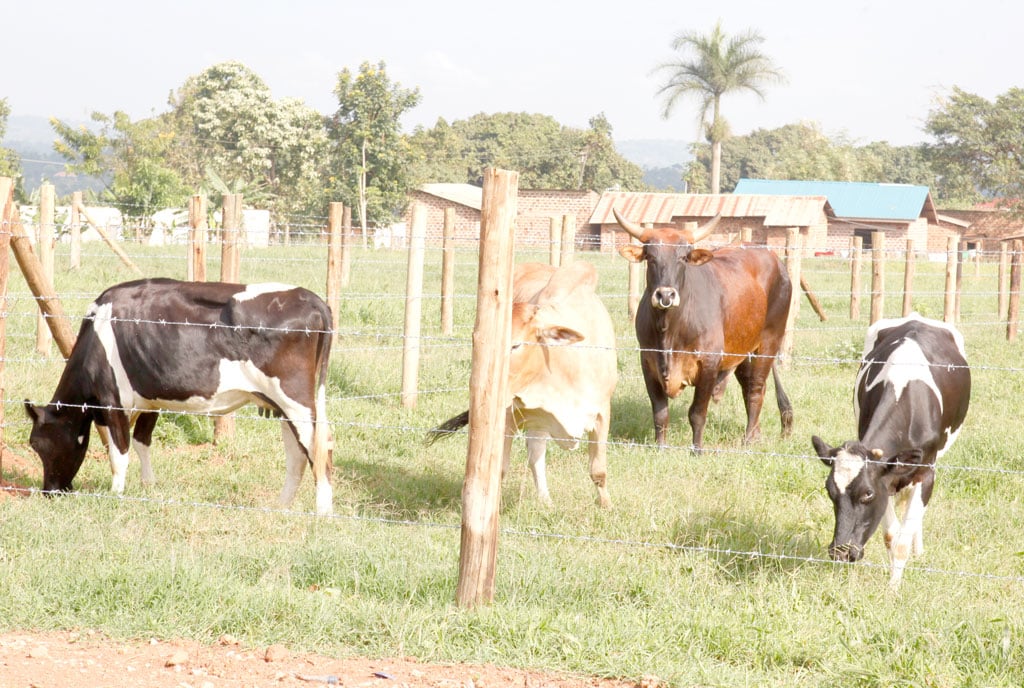Prime
How you can protect livestock from worms, leeches and flukes

Ensure the water you give to your animals is treated to avoid germs. PHOTO/NMG/FILE
What you need to know:
- Liver fluke can infect cattle, sheep and goats, as well as a range of other animal species.
- It is a zoonotic disease which means humans can also be infected.
- The lifecycle of the liver fluke requires two hosts, a small freshwater snail and the definitive host such as cattle, sheep, goats, and horses among others..
Just like humans who are faced with numerous health challenges arising from numerous diseases caused by different vectors, the same applies to animals.
In most cases, the ministries responsible for agriculture in African countries put emphasis on tick-borne diseases as a major threat to animal health.
These include diseases such as East Coast Fever, Bovine Babesiosis, Anaplasmosi, heart water and other zoonotic diseases such as Foot and Mouth Disease which has become a challenge in East Africa of late.
However, there are parasites in form of worm species which are a challenge to the livestock sector- causing economic losses. These include blood sucking leeches and liver fluke worms which are a challenge to livestock farmers in Sub-Saharan Africa including Uganda.
In Uganda the major challenge is liver fluke worms unlike in Ethiopia and parts of Africa where the blood sucking leech is a major problem.
Seeds of Gold had the opportunity to speak to science experts in Uganda and read through a research study detailing the challenge caused by leeches to livestock farmers in Ethiopia.
Below are the details: Background In a 2022 research publication by scientists from Ethiopia Helena Moreira, Henry T Akinbi and Ginette Ross about the dynamics of leech infestation in livestock and control practices in northwest Ethiopia, it is stated that leech infestation is a neglected ectoparasitic disease that affects livestock and causes significant economic losses to farmers due to loss of productivity, mortality and treatment costs.
Leeches belong to the phylum Annelida, the segmented worms are in the same class as earthworms. Their most notable features are their two suckers. The front sucker may have hardened teeth for feeding, whereas the rear sucker functions only as a suction-cup for grip.
Oftentimes both suckers are used for locomotion on a solid surface, creating a movement pattern like that of an inchworm. In open water, leeches are graceful swimmers and can be spotted swimming in an undulating motion.
In terms of appearance, leeches are usually dully coloured but can sport attractive spots and stripes. They have simplistic eyes in multiple pairs or rows.
Meanwhile, liver fluke can infect cattle, sheep and goats, as well as a range of other animal species. It is a zoonotic disease which means humans can also be infected.
The lifecycle of the liver fluke requires two hosts, a small freshwater snail and the defi nitive host such as cattle, sheep, goats, and horses among others.
Liver flukes in the case of Uganda
The director of Mbarara Zonal Agricultural Research and Development Institute (MbZARDI), Dr Halid Kirunda explains that leeches are present in Uganda, but they do not infest an[1]imals on farms unlike in other parts of Africa. He contends that livestock farmers in Uganda are faced with the challenge of liver flukes which are mainly found in swamps and are present in all parts of the country.
Citing the 2021 statistics compiled by abattoirs in the country, the economic loss caused in cattle as a result of damaged liver is 60 percent meaning such liver is unwanted and is usually destroyed upon slaughter of the cattle.
How does fluke affect animals?
Depending on the degree of infection, liver fluke may cause a reduced meat and milk production in cattle. Fertility can suffer and beef cattle affected by fluke may take an extra 80 days to reach market weights.
Conditions where liver fluke is likely to occur
Dr Kirunda notes that liver flukes are hosted by snails and so where there is a suitable habitat for the snail such as springs, marshy areas, water courses, water troughs and irrigated pasture, the fluke will be hosted.
Therefore, for the case of the farmers when the liver fluke snail is present on the farm this means the cattle will be infected by the fluke.
At least three species of snail, known to be intermediate hosts for liver fluke, occur in most countries in the world.
The most important is the freshwater snail, Lymnaea tomentosa. Other areas of occurrence is grazing paddocks with access to the snail habitats such as springs, swampy areas, water courses and irrigated pastures.
Identification and diagnosis
Liver fluke can produce either acute or chronic disease.
Acute disease is most common chronic disease in cattle and can occur any time but is most common during rainy season. Acute disease tends to follow a relatively short-term intake of a massive number of fluke cysts.
This causes substantial liver damage which results in weight loss and general ill-thrift, leading to reduced production of meat and milk.
Other symptoms are anaemia which can be seen through pale gums and membranes around the eyes. Gums and eyes may also turn yellow.
Prevention
Farmer are expected to adopt an integrated approach to liver control by avoiding introducing animals with liver fluke onto the farm.
Saturate all animals that come from a liver fluke area and keep them in a quarantine paddock for a day or two.
Always request an animal health statement when purchasing stock so you are aware of the disease status level of assurance that is being provided by the stock vendor.
Fence ‘flukey’ areas to prevent access by livestock and keep water troughs clean and free from snails.
Monitor the fluke status of livestock using either faecal samples to check for fluke eggs, a blood test, or reports on liver condemnations of animals sent for slaughter as well as avoid taking the cattle for water consumption in swamps with presence of snails.
Leech infection in livestock
Scientists from Ethiopia note that a leech infestation in livestock, is caused by bloodsucking, hermaphroditic, egg laying segmented worms found throughout the world and classified in the phylum Annelida and order Hirudinea.
It is a waterborne disease that infects animals when they drink water contaminated with leeches, while humans become infected when they drink, bathe, swim or walk through water contaminated with leeches.
Popular depictions of leeches often include concentric rows of sharp, fang-like teeth, or maybe an elongate ventral sucker that enables them to cling to their victim like the sticky-hand toys found in birthday goody bags.
Leeches as parasite and symptoms
According to the few but scattered study reports in Ethiopia, leech infestation of livestock is common in the highlands, where small streams and ponds are used to water livestock and the problem occurs mainly during dry seasons. The majority of reported cases and prevalence are from developing countries.
The mucous membranes of the nostrils and mouth are common predilection sites for aquatic leeches in the bodies of domestic animals. Coughing, blood in the nose and mouth, respiratory problems, emaciation and anaemia, and reduced milk yield have been reported in leech-infested animals.
Facts about the research study
The study animals include cattle, sheep, goats, horses and donkeys. The scientists selected both underage and adult animals including sheep, goats, cattle and horses for the study. They graded the body conditions based on the animal muscle, fat distribution and prominence of spine, hips and ribs.
Owners of livestock were included in this study as the study population and their biodata, knowledge, awareness and leech control practices recorded. These animals were castrated and restrained and their preferred sites for leech infestation oral cavity and nostrils were visually inspected for signs of leech infestation.
The leeches were then detached and removed with tweezers, stored in a plastic universal bottle of well water and labeled with the necessary information.
In addition, water bodies such as small streams, irrigation canals and wells that were potential sources of leech infestation for animals were surveyed.
The collected leeches from animals and water bodies were transported in an icebox to the Veterinary Parasitology Laboratory of the University of Veterinary Medicine and Animal Sciences, University of Gondar, where they were morphologically identified.
Source of leech infestation
The study results showed that leeches are prevalent in livestock communities in Ethiopia, and this applies to other parts of Africa. The source of leeches is small rivers, wells, irrigation canals and standing water bodies. If their livestock have direct access to infested water bodies, these become a source of leech infestation.
According to the farmers, livestock become infected with the parasite when they drink water from leech-infested water bodies and graze on leech-infested deforested areas.
The effects of leech infestation Leech infestation has direct impact on animal health and indirect impact on financial and social aspects.
In addition, in ick animals there is challenge especially of causing reduced milk yield, emaciation and respiratory problems and in rare cases deaths. They described clinical symptoms such as cutaneous bleeding, blood-tinged saliva and shortness of breath.
Management
Farmers use both traditional and modern medication methods to alleviate the problem. The traditional intervention method they use is done manually by removal and the treatment option they preferred to alleviate the problem was smoking of dried and rolled tobacco leaf powder.




